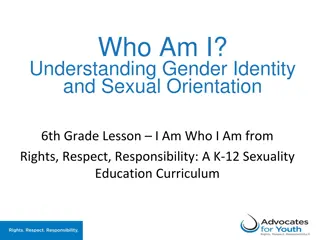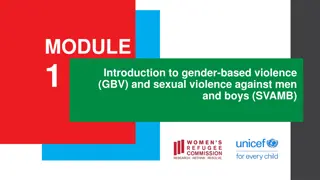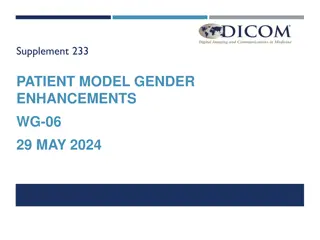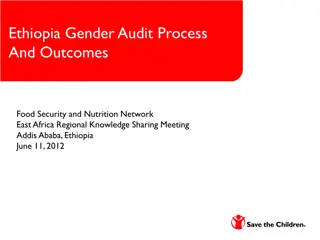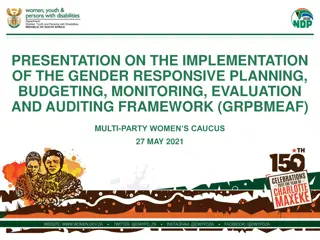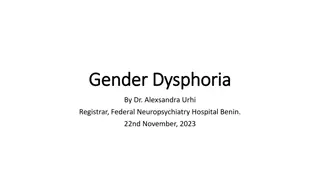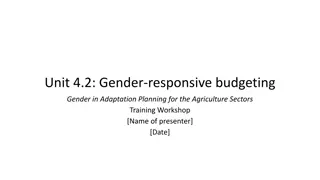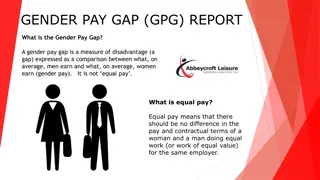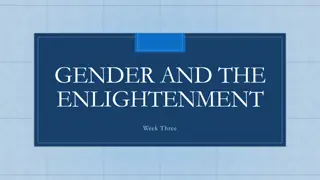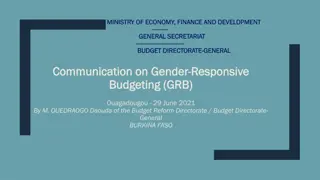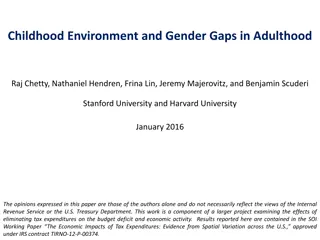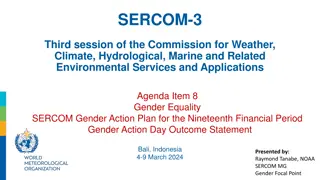Exploring the Relationship Between Language and Gender
The intricate relationship between gender and language is a subject of interest across various fields. While sex and gender are often used interchangeably, researchers distinguish them, with gender increasingly representing social identity. Sociolinguistics delves into how men and women use language differently and whether these distinctions arise from linguistic structures or societal dynamics. Questions arise around the existence of gendered-speech, linguistic differences between genders, sexist language, and the notion that women tend to use more standard forms than men.
Download Presentation

Please find below an Image/Link to download the presentation.
The content on the website is provided AS IS for your information and personal use only. It may not be sold, licensed, or shared on other websites without obtaining consent from the author. Download presentation by click this link. If you encounter any issues during the download, it is possible that the publisher has removed the file from their server.
E N D
Presentation Transcript
Language & Gender The relationship between gender and language has long been a matter of great interest for the general public as well as researchers in fields ranging from cultural studies to psychology to neurology to, of course, sociolinguistics.
Sex or Gender? 1 Though many people use the terms gender and sex synonymously, sociolinguistic and other researchers separate the two.
Sex or Gender? 2 In the 1980s, it was not at all unusual for a sociolinguist to describe their interests as being language and sex . However, in the intervening years, the term sex has largely been replaced by the term gender
Sex The term is restricted in sociolinguistics to refer to a biologically or physiologically based distinction between males and females. In other words, sex can be defined in terms of objective, scientific criteria that is, the number of X chromosomes a person has. 2 X = female , 1 X + 1 Y = Male
Gender Not grammatical gender (i.e., different classes of noun that may be called masculine , feminine ). Not sex of speaker which (largely) reflects biological or physiological differences between people. Gender is used increasingly in sociolinguistics to indicate a social identity that emerges or is constructed through social actions.
Questions Do the men and women who speak a particular language use it in different ways? If they do, do these differences arise from the structure of that language, or, alternatively, do any differences that exist simply reflect the ways in which the sexes relate to each other in that society, whatever the reason?
Questions Does gendered-speech really exist? Do linguistic forms used by men and women contrast? What is sexist language? Is it true that women use more standard forms than men?
Is it true that women use more standard forms than men? The social status explanation: Some linguists have suggested that women use more standard speech forms than men because they are more status-conscious than men. The claim is that women are more aware of the fact that the way they speak signals their social class background or social status in the community. Standard speech forms are generally associated with high social status, and so, according to this explanation, women use more standard speech forms as a way of claiming such status.
Is it true that women use more standard forms than men? Woman s role as guardian of society s values society tends to expect better behavior from women than from men. Little boys are generally allowed more freedom than little girls. Misbehavior from boys is tolerated where girls are more quickly corrected. Similarly, rule-breaking of any kind by women is frowned on more severely than rule-breaking by men.
Is it true that women use more standard forms than men? Subordinate groups must be polite People who are subordinate must be polite. Children are expected to be polite to adults. Women as a subordinate group, it is argued, must avoid offending men and so they must speak carefully and politely. Can t a woman express herself politely by using a non-standard vernacular or dialect?
Is it true that women use more standard forms than men? Vernacular forms express machismo (way of behaving that agrees with traditional ideas about men being very strong and aggressive) Men prefer vernacular forms because they carry macho (aggressive virile) connotations of masculinity and toughness. For this reason many women might not want to use such forms. They rather prefer to use standard forms which tend to be associated with female values and femininity
Who is possibly speaking? 1-a) Oh dear, you ve put the ice-cream into the refrigerator, again? 1-a) Damn! you ve put the ice-cream into the refrigerator, again?
Exclusive and Preferential Features Exclusive features or (Referential Indexes) are those which are only used by (or to) speakers of a particular sex. Preferential features or (Non-referential Indexes) are those that are distributed across speakers or groups, but are used more frequently by some than by others. These can be accomplished through a vast range of morphological, syntax, and phonological devices.
Exclusive Feature: Example 1 kinship terminology is a clear example of sex- exclusive terms, so for instance the phrase My Auntie Katty tells the listener that the person you are referring to is female. Similarly, the terms grandson and niece respectively tell you the referents are male and female. On the other hand, the term cousin might refer to a male or female.
Exclusive Feature: Example 2 In Korean the words for siblings tell you information about both the referent and the speaker, so the word hyeong tells you that the speaker is referring to an elder sibling (brother) that is the same sex as the speaker (elder brother for a male speaker). If a girl wants to refer to her elder brother, she would use a completely different word, oppa.
Directly Indexing Gender Elinor Ochs describes kinship terms as being a direct index of gender. Direct indexing means that a word has a semantic feature [+female] or [+male] as part of its basic meaning. Pronouns like he or she and titles Mr., Mrs., Sir and Madam directly index gender. That is, words directly indexing gender generate a conventional implicature that the referent is male or female. Conventional implicature refers to the inference that arises from the meaning (or semantics) of a word or phrase. This means if you try to cancel the implicature, it sounds bizarre or can t be understood. *My sister has cut himself.
Indirectly Indexing Gender Few features of language directly and exclusively index gender. Most variables associated with, e.g., male vs. female speakers only indirectly index gender. Their distribution is sex-preferential not sex-exclusive. They are generally associated with several other social meanings, e.g., casualness and vernacularity with masculinity. Because these other factors help to constitute what it means to be male the index between vernacular variants and male speakers/masculinity is indirect.
Characteristics of the language- Gender Relation 1. Non-Exclusive relation: Most linguistic features, beyond the lexicon (e.g kin terms), do not share such a strict relation to the semantic domain of gender. Rather, we find the relation between particular features of language and gender is typically non- exclusive. That means that often variable features of language may be used by/with/for both sexes. So, we cannot say that these presuppose male or female. We can only say that the features may be employed more by one than the other sex. features pragmatically
Non-Exclusive Relation: Example 1 In British and American English, women tend to use prestige phonological variants more than men of the same social class and ethnicity. They overuse the prestige variants, producing hypercorrect words. Women in New York city, for example, overuse the postvocalic /r/ to the extent that they sometimes insert an /r/ in a word that has no r in its written form. e.g instead of saying idea they hypercorrect to idear .
Non-Exclusive Relation: Example 2 Non-exclusivity is demonstrated by the fact that many linguistic forms associated with gender are associated as well with the marking of other social information, such as the marking of stance and social action. For example, tag questions in English are associated not only with female speakers, but with stances such as hesitancy, and social acts such as confirmation checks, clarifications, and feedback.
2. Constitutive Relation Positing a constitutive relation between language and gender means that one or more linguistic features may index social meanings (e.g. stances, social acts, social activities) which in turn helps to constitute gender meanings. Many of the linguistic features are associated primarily with either men or women have as their core social meaning a particular affective stance, social act, or social activity.
Constitutive Relation: Example A speaker uses one variant more than another, not because he is male but because in speaking like that he is constituting himself as an exemplar of maleness, and constituting that variant as an emblem of masculinity. For example, Japanese male speakers coarsely intensify the force of an utterance, while women convey an affect of gentle intensity. These features directly index coarse intensity and delicate intensity as part of the preferred images of men and women.
Approaches to language and gender
Deficit-based approach The deficit approach was characteristic of the earliest work in the field. Best known is Lakoff s Language and Woman s Place, which claims to establish something called women s language (WL), which is characterized by linguistic forms such as hedges, empty adjectives like charming, divine, nice, and talking in italics (exaggerated intonation contours).
Deficit-based approach holds that women s linguistic usages are inferior to men s and usually indicative of weakness. For example, it has been claimed that women demonstrate linguistic weakness through such arguably weak linguistic features as hedges, tag questions, and indirect requests and commands.
Deficit-based approach was challenged because of the implication that there was something intrinsically wrong with women s language, and that women should learn to speak like men if they wanted to be taken seriously.
Dominance-based approach sees women as an oppressed group and interprets linguistic differences in women s and men s speech in terms of men s dominance and women s subordination. Researchers using this model are concerned to show how male dominance is enacted through linguistic practice.
So, the Dominance-based approach focuses on women s relative powerlessness in comparison with men in describing and explaining women s vs. men s language.
Difference-based approach holds that women and men comprise separate subcultures and that it is early enculturation rather than inherent weakness or other essential characteristics that account for women s different language usages.
Difference-based approach emphasizes the idea that women and men belong to different subcultures. The discovery of distinct male and female subcultures in the 1980s seems to have been a direct result of women s growing resistance to being treated as a subordinate group. The invisibility of women in the past arose from the conflation of culture with male culture . But women began to assert that they had a different voice, a different psychology, and a different experience of love, work and the family from men
Difference-based approach The advantage of the difference model is that it allows women s talk to be examined outside a framework of oppression or powerlessness. Instead, researchers have been able to show the strengths of linguistic strategies characteristic of women, and to celebrate women s ways of talking.
The social constructionist approach Gender identity is seen as a social construct rather than as a given social category. As West and Zimmerman (1987) eloquently put it, speakers should be seen as doing gender rather than statically being a particular gender.
The social constructionist approach Gender identity is seen as a social construct rather than as a given social category. As West and Zimmerman (1987) eloquently put it, speakers should be seen as doing gender rather than statically being a particular gender. Linguists maintain that gender is not a static, add-on characteristic of speakers, but is something that is accomplished in talk every time we speak.
Doing Gender 1 1. "Doing gender means that gender is a routine accomplishment in everyday life. 2. We do gender every day, all the time. It's an ongoing activity. We can t avoid doing gender. 3. We do gender in interaction. 4. Gender is not simply what a person is, it is something that a person does, in interaction with others. It is a product of social interaction. A production. A construction. A social construction.
Doing Gender 2 5. And we do gender knowing that we will be judged by others. In other words, we are accountable for our gender performances. 6. If we behave outside the boundaries of normative gender scripts, we risk being judged harshly by others.
Doing Gender 3 Keep in mind that, from an early age, we learn about doing gender. Little girls are taught to value their appearance more so than little boys. Little boys are taught different things than little girls. Be a big boy and Be a big girl are different messages that convey different meanings about appropriate gender behaviors. This means not only "don't be a baby" but to learn how to "competently" be a boy or girl.
Doing Gender 4 In this process, boys and girls begin to monitor their own behavior and the behavior of their peers in terms of whether the gender behavior is appropriate. (Appropriate, according to normative gender behaviors). The authors write: "And note, to "do" gender is not always to live up to normative conceptions of femininity or masculinity; it is to engage in behavior at the risk of gender assessment"
Female Deficit Women s language: Lexical and Pragmatic Features Lackoff outlines lexical and pragmatic features of so-called women s language, among them, precise color terms (e.g. mauve, magenta), empty adjectives (e.g. divine, cute), high-rising intonation on declaratives and use of tag questions. Women tend to use hypercorrect grammar, including standard pronunciations such as going rather than goin and avoidance of non-standard forms like ain t. terminal (question)
















